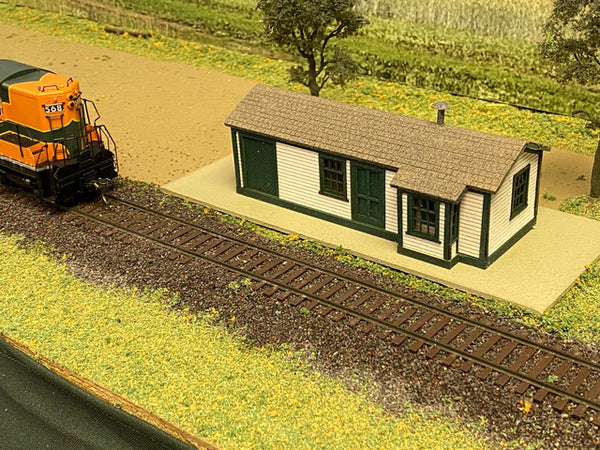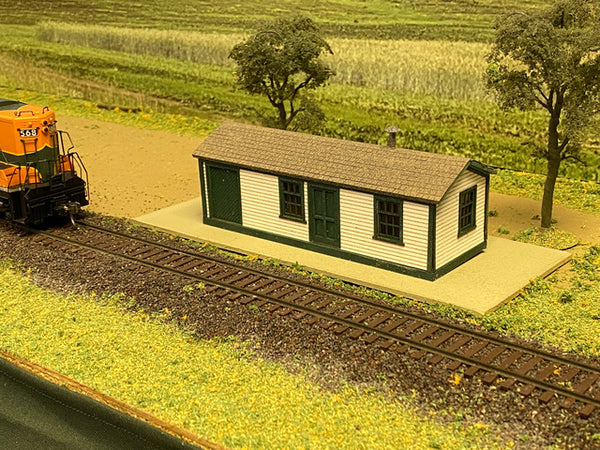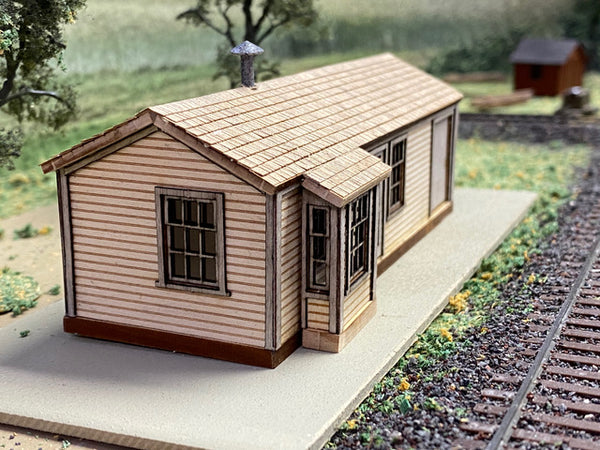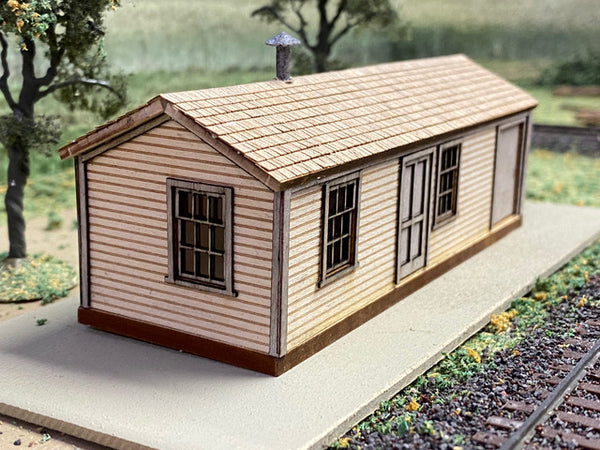Standard Portable Depot 12' x 34' - HO
This HO scale multimedia laser-cut kit of the GN 12 x 34 Standard Portable Depot kit is designed and produced for GNRHS by HRM Laser Models. The kit represents an important railroad structure that was built by the score and shipped by flatcar to towns all along the GN lines. Examples of this well-documented structure survive to this day. The kit can be built either left-handed, the Standard according to the plans, or right-handed, and with or without the bay window. Kit includes both original cedar shake roof and later three-tab asphalt shingle roof, so you can build with either roof. Window sashes are positionable, and have laser-cut Mylar glazing. Comes with laser-printed station signs. Footprint 1.95” D x 4.7” W.
Our kit can be built to represent any one of four variations:
- Version 1 left-handed with bay window and freight door on the right
- Version 2 left-handed as Version 1, but without the bay window
- Version 3 right-handed with bay window and the freight door on the left
- Version 4 right-handed as Version 3, but without the bay window
History
The Great Northern Standard 12’ x 34’ Portable Depot represents an historically important railroad structure, due to the sheer number of examples that were built. Beginning in about 1890, GN installed scores of these small depots along their lines in Minnesota, North and South Dakota, Montana, Idaho and Washington.
Designed to fit onto a flatcar, most of these depots were constructed in the GN shops at St. Cloud, Minnesota, and then shipped by rail to the towns needing them. Sometimes, these depots were intended to be temporary structures for use while a larger depot was built, refurbished or repaired. However, for the smaller towns that were springing up along the GN lines, a compact depot of this type was often all that was needed.
The depots were of wood-frame construction, and were divided into three rooms of approximately equal size: an office for the Agent and Telegraph Operators; a waiting room for passengers; and a freight room. The office and waiting room were heated by a single iron stove set in a two-foot wide opening in the wall separating the two rooms.
Although the GN drawings for the 12’ x 34’ Portable Depot were specific as to the locations of the various components, in fact there were at least a dozen documented variations from the standard. Some depots had bay windows and some did not.
Bays and freight doors appeared in different locations, and at times the freight door was replaced by a plain entry door and/or a window. In addition, some depots were built in a mirror-image of the design shown in the GN drawings.
Photographs showing many of these depots, along with other information and photographs, can be found on the Web sites for the Joint GN-NP Archives and the Skykomish Historical Society.
Small railroad structures such as the subject of this kit often ended their useful lives by being converted into maintenance sheds, yard offices, storage sheds or bunkhouses.
The Great Northern Railway changed its paint scheme for wooden buildings, including depots, from time to time. This makes the color of frame buildings a clue to the time frame you are modeling.
Paint Colors
Starting before 1900 depots were painted entirely mineral red. In 1909 new frame depots were painted medium yellow-buff on large wall sections with a darker olive-green trim on windows and doors, belt rails and corner posts. Older depots were repainted into the new colors when they required it. In September of 1930, the two-tone gray scheme of light gray on the main structure and darker gray trim on windows, doors, belt rails and corner posts was introduced. Again, existing depots were repainted as required. The gray was followed after 1950 by white as the main color with green trim on windows, doors, belt rails and corner posts. Photos taken in the middle and late 1960s show many depots painted all white with green trim only on windows. A few of the two-tone gray depots were never repainted until after the BN merger. Station name boards were always white with black lettering and black trim along the edges.
See RS 35, RS 53, 154, RS 397, and RS 402.
Explanatory notes:
Note 1: No evidence has been found in AFE or corporate files for dark green or red trim, on early mineral red depots. All reference to dark green or red trim is anecdotal and not supported by any documents, but some think it is consistent with available black and white photos.
Note 2: The change to yellow-buff with olive green trim was made official with the new 1909 depot style featuring belt rails, boxed eaves, angled bay, and different siding widths above and below the belt.
Note 3: In Reference Sheet 402 the term “yellow-buff” was used, rather than the yellow-ochre of RS 53 which called the depot trim a “darker ochre.” That term is very confusing and not at all descriptive of a color with a definite green cast. There was some confusion among GNRHS members about these colors when these ochre descriptions were written in the 1970s.
Note 4: Existing “old-style” depots continued in service after 1909. It took time for existing depots to be painted in the new colors; some never were, but went directly to two-tone gray sometime after September, 1930, when that standard was introduced.
Note 5: Actual boards collected from several depots now exist in the JSRH Archives in St. Paul. These boards have colors consistent with the colors as described here. The colors stated here are also confirmed in documents and corporate files located at JSRH and Minnesota History Museum. Martin Evoy’s extensive files preserved at JSRH have also been carefully examined, as well as paint chips collected by Martin and others.
Note 6: A few depots located on the branch between Alexandria, MN and St. Cloud, MN are thought to have been painted gray with mineral red trim. Examination of paint layers on the boards in the depot in Dalton, MN supports this.










